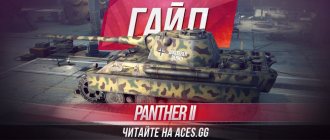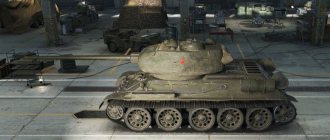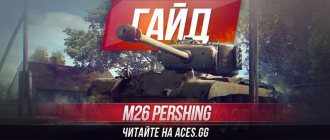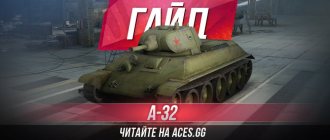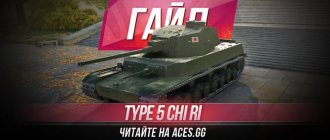Tank Mk I
Vickers Mk.I tank
In November 1915, the engineering company U. Foster began creating a new combat vehicle. Basic requirements: a small tracked vehicle with bulletproof armor, capable of overcoming craters up to 4 meters wide and wire fences, moving at a speed of at least 4 km/h, a crew of no more than 6 people and having weapons: one or two cannons and machine guns.
An unusual solution was to put the upper branch of the caterpillar on top of the body; the shape of the caterpillar was similar to a parallelogram, which increased the vehicle's maneuverability. On January 30, 1916, the armored vehicle was presented to the customer - the British War Office. After passing the tests, the car was called “Big Willie”; the car went into production under the name “Mk.I”.
According to the classification that existed at that time in Great Britain, vehicles weighing more than 30 tons were considered heavy, medium - from 10 to 30 tons, and less than 10 tons light. There was also a classification by weapons: “males” with a cannon and “females” with a machine gun. Combat weight of Mk-1: “male” - 28 tons, “female” - 27 tons. Speed 4.5 km/h (over rough terrain - 2 km/h), range 19 km. The armor was 5-11 mm. Armament on the male: two 57-mm cannons and 3 “Gochkiss” machine guns; on the female: five machine guns installed in sponsons. Crew – 8 people. The box-shaped body of the tank was made of corners, to which armor plates were bolted.
The chassis consisted of 26 small unsprung main wheels located between the inner and outer armor plates. The upper branch of the caterpillar was supported by a special rail. Two wheels were installed at the rear for steering while moving; the tank turned in place by braking one track. The pressure on the ground, with a track width of 520 mm, reached 2 kg/cm2. A Daimler engine, fuel tanks, and a gearbox were installed inside the hull; additional onboard gearboxes were installed along the sides, between the armor plates. Three people were involved in driving the tank: the driver, who changed the main gear and engine speed, and two assistants, who switched the onboard gearboxes and braked the tracks. The driver gave commands to the assistants by voice.
The armament was installed in the side protrusions - sponsons. The cannons and machine guns had almost all-round fire. When transported by rail, the sponsons were removed to reduce dimensions. The unsprung suspension made shaking and noise, and the lack of ventilation made the crew's work not easy.
A total of 150 Mk.Is (split males and females) were built.
Year of creation - 1916 Combat weight, tons - 28.4 Crew, people. – 8 Length, m – 9.91 Width, m – 4.11 Height, m – 2.44 Armor: Front, mm – 12 Side, mm – 10 Top, mm 6 Armament: Gun type – Hotchkiss, Caliber 2 x 57 mm Barrel length in calibers – 23, Ammunition – 324 Hotchkiss machine gun, Caliber 4 x 7.7 mm Ammunition – 6272 Chassis: “Daimler” engine Power, hp – 105 Max. speed, km/h – 4.5 Fuel reserve, l – 210 Cruising range on the highway, km – 37 Ground pressure kg/cm2 – 1.19
English battle tank
"Big Willie", "Wilson's Machine", "Mother", "Centipede", "Mark-1", Mk.I tank.
E. Swinton (Ernest Dunlop Swinton) addressed the commander of British troops in Europe, General George French (George Arthur French), reporting on the ongoing experiments (“On the need for machine gun fighters”). The general responded, and the officers from headquarters outlined in detail what kind of vehicle they needed. The future “land battleship” was supposed to have bulletproof armor, overcome craters with a diameter of up to 4 meters and wire fences in several rows, and reach a speed of at least 4 km/h on the ground. The armament was to consist of one cannon and two machine guns, and a crew of 6 people.
"Little Willie"
A prototype on the Bullock tractor chassis, under the leadership of engineer W. Tritton, Lieutenant W. Wilson and G. Ricardo, was built in 40 days at the W. Foster engineering plant in Lincoln. They named the car "Little Willie". With a combat weight of about 18 tons, its armament was to consist of a 40-mm Maxim automatic cannon located in a turret in the center of the hull. No armament was installed and she was tested with a false turret (for weight). It should be noted that it was made before the specifications were approved by the military, so although the tests ended successfully, it was decided that “Little Willie” was not yet suitable for combat.
The main disadvantage was that it could not overcome 4-meter craters due to the insufficient length of the supporting surface of the tracks. The engineers had the idea to give the tank tracks a diamond-shaped shape, and place the hull and weapons between them. This design made it possible to overcome vertical obstacles, of which there are always many on the battlefield, and, if necessary, to easily transport it by rail by making the side weapon compartments (sponsons) removable.
Tank "Big Willie" during testing on February 2, 1916.
Contrary to the technical specifications
The choice was finally made in favor of a vehicle with rhombic tracks, called the “Big Willie” tank, and then “Mother”, the first sample of which Foster’s company released at the end of 1915, and already on January 30, 1916 presented the vehicle for testing. On February 2, 1916, in Hatfield Park near London, it was observed by the Minister of Armaments D. Lloyd George, who soon became the Prime Minister of Great Britain, and Sir Winston Churchill even climbed into it through the door in the sponson.
Tank "Big Willie"
The car successfully climbed through the ditches and craters dug in the park. The first tank , of course, had many shortcomings; it turned out to be both inactive and fragile, but it fully answered the tasks assigned to it. In connection with this, it was decided to immediately order 100 of these “land battleships” and test them in the battles of the First World War.
The first tank was known by a number of names - “Big Willie”, “Wilson Machine”, “Mother” and even “Centipede”; it entered mass production with the designation “Mark-1”, or the Mk.I tank for short. For tanks, a division was invented into “females” and “males” based on the type of weapons installed on them.
- The first type ("male") was a cannon type and was armed with two naval 6-pounder (57 mm) guns with an effective firing range of 1800 m and a rate of fire of 15-20 rounds per minute.
- The second type (“female”) was armed with six Vickers machine guns and had no cannons.
A total of 75 “males” and 75 “females” were produced, and in battle the cannon tanks were supposed to support the machine gun tanks.
Tank "Mark I" (male).
Mk.I tanks, 1916-1917
| Click on the tank photo to enlarge | ||
It should be noted that the first English tank was born contrary to the technical specifications issued for it, which stated that the vehicle should have a 40-mm Maxim automatic cannon, which received the characteristic name “Pom-Pom” in the British army and two machine guns, but Mk .I did not correspond to this.
Sources:
- IN. Shpakovsky. “Tanks from the era of total wars. 1914-1945";
- G.L. Kholyavsky “Complete encyclopedia of tanks of the world 1915 - 2000”;
- Steven J. Zaloga,"French tanks of World war 1";
- David Fletcher. British Mark IV Tank;
- S. Fedoseev. "Land ships". English heavy tanks of the First World War period (Armor collection No. 5 (32) / 2000);
- R. P. Hunnicutt. Firepower: A History of the American Heavy Tank;
- David Fletcher. British Tanks 1915-19.
| < Back |
Links[edit]
- Tucker, Spencer (2004). Tanks: An Illustrated History of Their Impact
. ABC-CLIO. pp. 49–51. ISBN 1-57607-995-3. - Forty, George; Livesey, Jack (2006). World Encyclopedia of Tanks and Armored Fighting Vehicles
. Books by Lorenz. ISBN 978-0-7548-1741-3. - WWIIvehicles.com, accessed October 23, 2007.
- Bingham, James (1971). Crusader – cruiser Mark VI
. AFV profiles. Windsor: Profile Publications. OCLC 54349416. - Chamberlain, Peter; Ellis, Chris (1981) [1969]. British and American tanks from World War II
. Arco Publishing House. ISBN 0-668-04304-0.
Design and development [edit]
Main article: Cruiser tank
In 1936, the British War Office identified two different types of tanks for future development: heavily armored infantry tanks to be used closely with infantry during attacks, and fast mobile cruiser tanks designed for forays deep into enemy territory.
Due to cost, British designs to replace the Medium Mark II tanks then in service were cancelled, with only three built. In 1934, Sir John Carden of Vickers-Armstrong was asked to provide a "reasonably cheap tank" as a replacement for some of the medium models then in use. This design was known from the General Staff specification A9.
A prototype of his medium tank was built in 1936 and designated A9E1.
It incorporated the best features of the canceled Medium Mk III design, but was lighter so that it could be powered by a commercial petrol engine. However, this was still during the Great Depression, and a number of cost-cutting measures were applied to the tank. It was the first British tank with a central turret and mechanical rotation. The system was developed by Nash & Thompson and is similar to that implemented on the Vickers Wellington bomber. The armor was light, with a maximum thickness of 14 mm. Many armor surfaces were vertical and there were many shot traps, but it could reach speeds of 25 mph (40 km/h) and carried the new high-velocity QF two-pounder (40 mm) gun, which replaced the 3-pounder gun QF by the time production began in 1937.
The control section and the fighting section were not separated. In addition to the turret armament, which consisted of an Ordnance QF 2 pounder gun and a coaxial Vickers machine gun, there were two small turrets on each side of the driver's cab, each equipped with a Vickers machine gun. Both of these smaller turrets were permanently manned, giving the tank a full crew of six (commander, gunner, loader, driver and two machine gunners).
The A9E1 was tested against other designs, and although it was lacking in some areas, it was accepted in 1937 as an interim design until the Christie suspension cruiser tank could be delivered. An order was placed for 125 pieces. Seventy-five were built by Harland and Wolff, and the remaining 50 were built by Vickers. The development model was initially powered by a Rolls-Royce automobile engine (7.67 L Phantom II), but this was found to be underpowered and was replaced by a 9.64 L AEC bus engine. [3]
The later Valentine infantry tank essentially used the same lower hull and suspension, but with significantly more armor.
The A9 weighed 12 long tons (12 t), was 19 ft (5.8 m) long, 8.7 ft (2.65 m) high, 8.2 ft (2.5 m) wide and had a top speed of 25 miles per hour (40 km/h). ) on the road and 15 mph (24 km/h) on the exit. Its maximum range was 150 miles (240 km). Ammunition was 100 rounds for the main gun and 3,000 rounds for three machine guns.
Service [edit]
A damaged Cruiser Mk I CS abandoned at Calais, 1940.
The Mark I cruiser began delivery in January 1939.
The cruiser was an effective tank in the French, Greek and early North African campaigns. The 2-pounder was lethal against the first Italian tanks encountered during the North African Campaign and could hold its own against Rommel's early Panzer IIs and IIIs. The A9's 2-pounder gun could also penetrate 20-30mm of protective steel from later enemies such as the Panzer III D and Panzer IV D variants. It was effective until the Germans introduced the thicker armored Panzer variant to the desert in the spring of 1941 IVE. However, its minimal armor made the A9 very vulnerable to most Axis anti-tank weapons. Also problematic was the lack of high-explosive shells for the 2-pdr gun and, even worse, the lack of armor-piercing shells for the 94 mm gun on the Close Support version. Another problem was that the areas around the forward machine gun turrets created a frontal surface that was more vulnerable to enemy fire than if it were a simple flat plate.
The Cruiser's mechanical unreliability was also a drawback. In particular, the tracks turned easily, which created difficulties.



